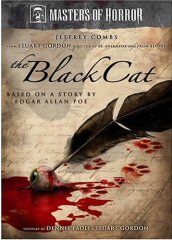
One of the most mature and psychologically complex entries in the MOH series, The Black Cat is steeped in grand Gothic imagery and a darkness both metaphorical and literal, suggesting both the story's long ranging effects and the director's growing craft. The Black Cat is also a thoughtful if exploitative nod of respect to one of the genre's most misunderstood greats. The story itself charges into the troublesome question of just how deeply art and life imitate one another, using as its focal point Edgar Allan Poe. This characterization is made up of varying pitiful and horrific traits, some true to his tragic and troubled experiences, others fictitious as his personality is integrated into the unnamed narrator of the short story upon which this introspective film was based.
A nod of the head to post-modernism, The Black Cat manages to make its experimental trait work for it. The merging of historical detail with one of the author's own tales makes this script both a biographical study and a comment on art -- without humiliating or completely changing the original. The narrator of the original text becomes Poe himself, re-living the pain and terror of the narrator in the short story, "The Black Cat." Clever writing and sleek direction establish many similarities between Poe the man and the Poe the 'character.' The script maintains such a balance between obsession and violence that it is difficult to tell where one ends and the other begins. A sense of hallucination and meta-reality expands the theme primarily favored in this drama -- the deceptive differences and/or similarities between reality and nightmare, sanity and madness. Adapted by Dennis Paoli and Stuart Gordon, the original team behind the much less faithful adaptation of Lovecraft's work, Re-Animator, the script focuses on what inspired Poe as an author to write the "Black Cat" at the same time that it re-tells that very same story, crossing the traditional dividing line between art and life. This allows several intimate and historically correct elements of Poe's fascinating and heartbreaking life to shine through the central narrative of a man's obsession with a cat. Poe's habits and personality are revealed as he descends into greater personal helplessness, poverty and estrangement -- all of which lead to murder and his particular enslavement to the 'imp of the perverse.' Poe is an alcoholic living without credit or respect, while his beloved wife-cousin slowly dies from consumption (which really happened). The principle tension of the story hangs on the unique manner by which Gordon shows Poe struggling with everyday dilemmas, finding a dark union between psychosis and necessity in the realm of art and violence.
Poe's Black Cat was one of the author's handful of morbid masterworks. Combining physical revulsion with a more penetrative examination of man's urge to satisfy the 'imp of the perverse' (that instinct that drove man to gravitate towards the wrong and evil for its own sake), this story reflected Poe's penchant for merging the internal and emotionally troubled minds of alienated male characters with supernatural themes. While the original story was devoid of any clear supernatural manifestation (unlike Legia or The Fall of the House of Usher), the atmosphere and narrator's struggle with altered realities and madness suggest an occult influence. The film, like the story, (and Poe's method in general) marry the supernatural and madness together with the tool of perception. This philosophically dark attention to identity and obsession, and the importance of one's perspective in deciphering the horrific worlds within and outside oneself, are lent further terror by Gordon's emphasis on cruelty and viscera. While this at first glance may make Poe purists cringe, as many of his darkest effects were achieved through the mind, upon reflection you'll realize that Poe himself often indulged in sudden jolts of graphic excess and violence. The gore and physical carnage isn't used to replace thinking, story, or characterization, but to enhance it.
The presentation of The Black Cat is just as luscious and decadently beautiful as the cinematography itself. Presented in 1.78:1 Anamorphic Widescreen, this print is clean and sharp, without grain or any distortion. Deep, moody splashes of color contrast wonderfully with the sombre, dark, convincing environment. This is, quite simply, an orgy of funeral decadence and moroseness, matching perfectly some of the chief qualities of Poe's literary work. Audio tracks are featured in both in Dolby Surround Sound 5.1 and Dolby Digital 2.0. While the later sounds stronger, both are clean and vibrant.
Extras for this fearsome feast include "The Tell-Tale Cat: Making of the Black Cat," "Bringing Down the Ax: A Look Behind the FX of The Black cat," a Photo Gallery, and an Audio Commentary with Stuart Gordon and Jeffrey Combs. The commentary is easily the most significant of these, insightful and wildly entertaining as Combs and Gordon reflect on craft, process, their careers, and the obvious fun they had on set. Both men are intelligent and articulate, and their insights into the arts easily worth a second listen.
Review by William Simmons
| Released by Starz/Anchor Bay |
| Region 1 - NTSC |
| Not Rated |
| Extras : |
| see main review |